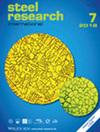烧结过程中 CO 生成和燃烧效率的数值模拟:固体燃料粒度的影响
IF 1.9
3区 材料科学
Q2 METALLURGY & METALLURGICAL ENGINEERING
引用次数: 0
摘要
针对各种燃料粒度分布的烧结锅生产过程,使用 Fluent 2021R1 开发了基于计算流体动力学方法的瞬态数值模拟烧结模型。该模型结合了化学反应、传质和传热、欧拉-欧拉模型以及多孔介质中的流体流动。本研究采用 CO 作为燃烧的中间产物,在高温区通过二次燃烧进一步氧化。通过计算,对不同燃料粒度分布下烧结过程中的床温变化、CO 排放和固体燃料燃烧效率等固体燃料燃烧行为进行了综合解释。在烧结过程中,燃料粒度分布对降低 CO 排放和提高燃烧效率至关重要。随着固体燃料粒度的减小,燃烧效率呈现先升高后降低的趋势,而 CO 排放量则呈现先降低后升高的趋势。降低烧结过程中的 CO 排放量是有利的,当粒径为 5 毫米的固体燃料比例减少,粒径为 3 毫米的固体燃料比例增加时,烧结过程的燃烧效率将大大提高 5.13%。本文章由计算机程序翻译,如有差异,请以英文原文为准。
Numerical Simulation of CO Generation and Combustion Efficiency in Sintering Process: Effect of Solid Fuel Particle Size
For sintering pot productive process with various fuel particle size distributions, a transient numerical simulation sintering model based on the computational fluid dynamics approach is developed using Fluent 2021R1. The model combines chemical reaction, mass and heat transfer, Euler–Euler model, and fluid flow in porous media. In this study, CO is employed as the combustion's intermediate product, which is further oxidized by secondary combustion in the high‐temperature zone. Through calculations, the solid fuel combustion behavior of the sintering is explained collectively with the changing bed temperature, CO emission, and solid fuel combustion efficiency of the process under various fuel particle size distribution. In the sintering process, the fuel particle size distribution is crucial for lowering CO emissions and increasing combustion efficiency. The combustion efficiency shows a tendency of increasing initially before decreasing with the reduction of solid fuel particle size, while CO emissions show a trend of reducing first and then increasing. It is advantageous to lower the CO emission in the sintering process, and the combustion efficiency of the sintering process is greatly boosted by 5.13% when the proportion of solid fuel with 5 mm particle size decreases and the proportion of solid fuel with 3 mm particle size increases.
求助全文
通过发布文献求助,成功后即可免费获取论文全文。
去求助
来源期刊

steel research international
工程技术-冶金工程
CiteScore
3.30
自引率
18.20%
发文量
319
审稿时长
1.9 months
期刊介绍:
steel research international is a journal providing a forum for the publication of high-quality manuscripts in areas ranging from process metallurgy and metal forming to materials engineering as well as process control and testing. The emphasis is on steel and on materials involved in steelmaking and the processing of steel, such as refractories and slags.
steel research international welcomes manuscripts describing basic scientific research as well as industrial research. The journal received a further increased, record-high Impact Factor of 1.522 (2018 Journal Impact Factor, Journal Citation Reports (Clarivate Analytics, 2019)).
The journal was formerly well known as "Archiv für das Eisenhüttenwesen" and "steel research"; with effect from January 1, 2006, the former "Scandinavian Journal of Metallurgy" merged with Steel Research International.
Hot Topics:
-Steels for Automotive Applications
-High-strength Steels
-Sustainable steelmaking
-Interstitially Alloyed Steels
-Electromagnetic Processing of Metals
-High Speed Forming
 求助内容:
求助内容: 应助结果提醒方式:
应助结果提醒方式:


